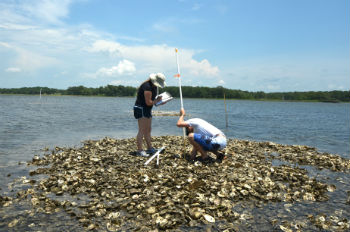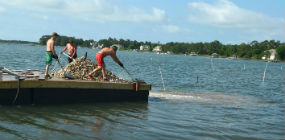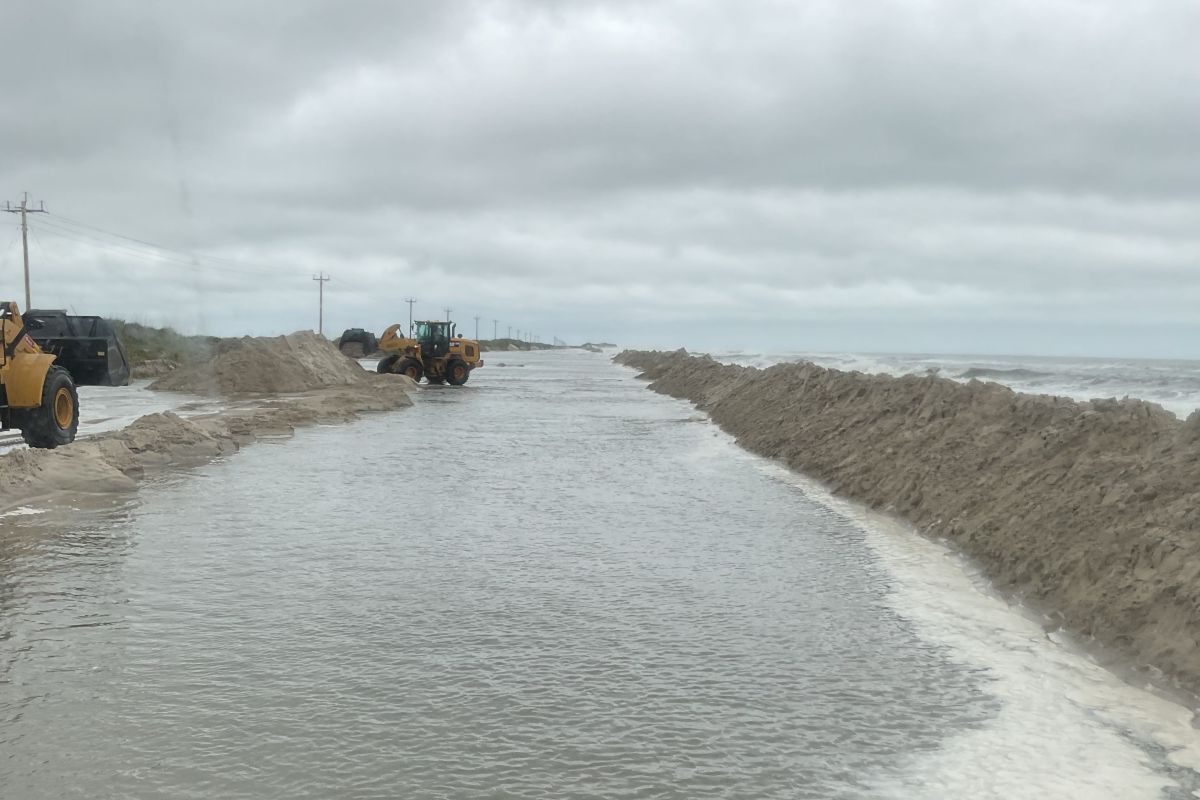 Two federation interns take measurements of the newly constructed oyster reef patches in the Lockwood Folly River. The project is part of the federation’s on-going work to help restore the water quality of the river. Photo: Tess Malijenovsky |
VARNAMTOWN — When it wrapped up last month, the project was a milestone for the N.C. Coastal Federation, an environmental nonprofit that has been working with Brunswick Country since 2008 to help restore the water quality of the Lockwood Folly River. While other federation projects continue on land in the county, the 21 patches of oyster reef mark the end of their work in the water, at least for now.
It’s a curious sight, the piles of oyster shell with white poles checkering three acres on a mud flat, just before you reach the docks at Varnamtown. Though it may look like an odd art installation, the patches are precise, calculated oyster restoration work. They will become reefs as baby oysters, or spat, attach to the old shell; and according to research, fish favor the mosaic design, which creates eddies that allow spat and food particles to drop down and the oysters to be more effective filters of the river.
Supporter Spotlight
Restoring the river has been a priority for the federation in part because of its potential to recover. “We started working on Lockwood Folly River a while ago and one of the reasons is because the river has some pollution degradation issues but a lot of the watershed is still intact,” said Ted Wilgis, an educator for the federation who led the oyster restoration work.
“It hasn’t been developed to the extent of some other watersheds so there’s the potential of being proactive and using LID (low-impact development) and planning to allow for the protection and restoration of the river,” he said.
The black river snakes quietly through the primitive marshlands of Brunswick County. Fishermen and locals from Supply to Sunset Harbor relish this secret wilderness of the Southeast. “The Lockwood Folly River traditionally was one of the best oystering watersheds in the southeastern coast,” said Mike Giles, a coastal advocate for the federation.
 Fishermen and locals from Supply to Sunset Harbor relish this secret wilderness of the southeast N.C. coast, the Lockwood Folly River. Photo: Tess Malijenovsky |
However, it’s changed since the county became one of the fastest growing in the nation. According to the state, today 85 percent of the river’s shellfish waters are closed permanently or temporarily to harvest because of high bacteria levels.
The culprit is unassuming. As Giles will explain, “It’s about runoff from the land, how we changed the natural ability of the landscape to absorb the rainwater, which contains pollutants from wildlife, from pets, from a variety of sources.”
Supporter Spotlight
The federation began working with Brunswick County officials, local communities and various state and federal agencies to address this stormwater runoff problem and reverse the trends of shellfish closures.
 The two oyster reef patches, foreground, will mimic the function of the existing strip of oyster reef next to them in the middle of the Lockwood Folly River. Photo: Tess Malijenovsky |
“We can’t really affect or change the source because it’s a natural source, it’s always been there. Pets have added to it. What we can change is the pathway of the water,” said Giles.
A watershed restoration plan was designed to do just that; it retrofitted existing properties and encouraged developers to change the way stormwater flowed on new construction sites so that the runoff could soak into the ground rather than rush into the river. The plan included working directly in the river building oyster reefs to improve its water quality.
“What we try to do when we have a project like this and we develop a watershed plan is connect projects in the water with the things we’re doing on the land. So the oysters and the replenishment and restoration of natural oyster beds directly connect to what we’re trying to do on the land,” said Giles.
Living, thriving oysters – even the ones that aren’t safe to eat – help clean the water by filtering pollutants and sediments. Also, the oyster reefs become a habitat for other marine animals. Not only will they attract more fish, but they will produce more spat in the river, which means more oysters downstream where the water quality is good enough to harvest.
The project’s benefits come on many fronts, according to the federation. Improving the fishery indirectly stimulates the local economy; people come to the area to fish and fishermen work in the river. The project contractor, Chris Connaway, of Connaway Marine Construction, hired locals of Varnamtown to help with the work too. The federation wants their restoration work to have a diversity of benefits, said Wilgis, to the environment, the fishery and the local economy.
 Chris Connaway and two hired locals shovel oyster shell into piles that will eventually become oyster reef patches. The federation says that the oyster restoration project benefits the ecology, the fishery and the local economy. Photo: Tess Malijenovsky |
Connaway made a point to talk to the locals about the project. “Instead of trying to be standoffish about it, I go right at them, bring them out here, tell them what we’re doing,” he said. “There’s some older, hardcore fishing guys who look at it (like) it might be a detriment to do something like this, especially in a site that’s contaminated.
“When hurricane Fran and the red tide hit years ago, really devastated this area. The locals understand that it takes a lot of time for it to come back, but some of them had felt like this was probably going to slow the water down in here and not let the water flush quite as good; but after they’ve seen the reefs put in place everybody’s happy with it.”
They’ve been extra friendly in fact, said Connaway, “coming out of the wood works” to offer help. Both Connaway and Wilgis expressed gratitude for the town, which allowed them to store the oyster shell – 12,000 bushels weighing 780,000 pounds — on land near the loading docks.
Along with this project, the federation also helped install 200 feet of living shoreline – a combination of a sill made of bagged oyster shells and planted saltmarsh cordgrass – at a park in Oak Island in 2013 and another in St. James in 2007. The federation says the projects help improve the water quality of the Lockwood Folly River and provide habitat for fish.







